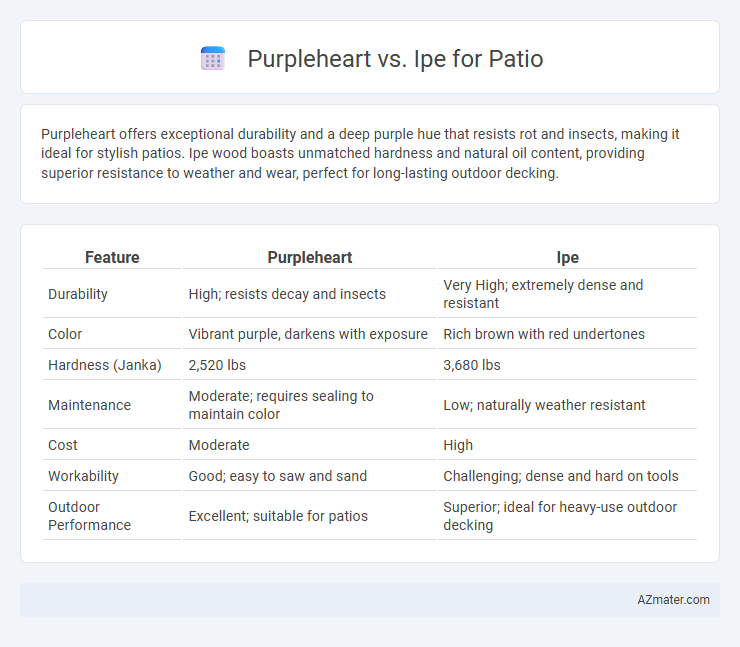Purpleheart offers exceptional durability and a deep purple hue that resists rot and insects, making it ideal for stylish patios. Ipe wood boasts unmatched hardness and natural oil content, providing superior resistance to weather and wear, perfect for long-lasting outdoor decking.
Table of Comparison
| Feature | Purpleheart | Ipe |
|---|---|---|
| Durability | High; resists decay and insects | Very High; extremely dense and resistant |
| Color | Vibrant purple, darkens with exposure | Rich brown with red undertones |
| Hardness (Janka) | 2,520 lbs | 3,680 lbs |
| Maintenance | Moderate; requires sealing to maintain color | Low; naturally weather resistant |
| Cost | Moderate | High |
| Workability | Good; easy to saw and sand | Challenging; dense and hard on tools |
| Outdoor Performance | Excellent; suitable for patios | Superior; ideal for heavy-use outdoor decking |
Introduction to Purpleheart and Ipe for Patios
Purpleheart and Ipe are two highly durable hardwoods popular for patio construction, valued for their exceptional resistance to weather, insects, and decay. Purpleheart is known for its vibrant purple hue that intensifies with exposure and offers excellent stability and hardness, making it suitable for outdoor flooring that withstands heavy foot traffic. Ipe, often referred to as Brazilian Walnut, provides a rich brown color, extreme density, and natural oil content that resists moisture and UV damage, ensuring long-lasting, low-maintenance patio surfaces.
Overview of Purpleheart Wood
Purpleheart wood is a dense, durable hardwood renowned for its vibrant purple hue that darkens to a rich brown with exposure to sunlight. Native to Central and South American rainforests, it offers excellent resistance to decay, fungi, and insect attacks, making it ideal for outdoor applications like patios. Its hardness and stability provide a long-lasting surface, comparable to Ipe, but with a unique aesthetic appeal that blends strength and natural beauty.
Overview of Ipe Wood
Ipe wood, renowned for its exceptional density and durability, is one of the most popular choices for patio decking due to its natural resistance to rot, insects, and wear. Its deep brown color with subtle grain patterns offers a sophisticated and long-lasting aesthetic that can endure harsh weather conditions without warping or splintering. Compared to Purpleheart, Ipe requires minimal maintenance while providing superior strength and stability for outdoor use.
Durability: Purpleheart vs Ipe
Purpleheart offers impressive durability with natural resistance to rot, decay, and insect damage, making it a solid choice for patios. Ipe wood, known for its exceptional hardness and density, surpasses Purpleheart in longevity, often lasting 40+ years with minimal maintenance. Both woods withstand harsh weather conditions, but Ipe's superior toughness and resistance to wear make it the preferred option for heavy-use outdoor areas.
Weather Resistance Comparison
Purpleheart and Ipe are both prized hardwoods known for exceptional weather resistance, making them ideal choices for patio construction. Purpleheart offers superior durability with natural oils that resist moisture, decay, and insect damage, maintaining stability in diverse climates. Ipe also excels with a dense grain and high hardness rating, providing excellent resistance to UV rays, rot, and fungal attacks, ensuring long-lasting performance in outdoor settings.
Color and Appearance Differences
Purpleheart wood exhibits a vibrant, rich purple hue that deepens to a dark chocolate color over time, providing a striking and unique aesthetic for patios. Ipe, on the other hand, showcases a more traditional, warm brown tone with subtle reddish or olive undertones, known for its smooth, dense grain and natural luster. The distinct color transformation and bold saturation of Purpleheart offer a more exotic appearance compared to Ipe's classic, earthy elegance, making each suited to different design preferences for outdoor spaces.
Maintenance Requirements
Purpleheart requires moderate maintenance, including periodic sealing and cleaning to prevent discoloration and surface wear, while Ipe demands less frequent upkeep due to its natural resistance to rot, insects, and weathering. Both hardwoods benefit from annual cleaning and occasional re-oiling to maintain their rich color and durability under outdoor conditions. Ipe's dense grain structure offers superior longevity with minimal intervention compared to the more porous Purpleheart, which can be prone to fading if left untreated.
Sustainability and Environmental Impact
Purpleheart and Ipe both rank high in sustainability due to their natural durability and dense grain structures that reduce the need for chemical treatments. Purpleheart is sourced primarily from Central and South American forests with certified harvesting practices supporting forest regeneration, while Ipe, native to the Amazon, often comes from FSC-certified suppliers ensuring responsible forestry management. The long lifespan of both woods minimizes carbon footprint by reducing replacement frequency, making them environmentally preferable choices for eco-conscious patio construction.
Cost and Availability
Purpleheart wood typically costs less than Ipe, making it a more budget-friendly option for patio decking. Ipe is known for its exceptional durability but is often priced higher and can be harder to source due to its popularity and limited availability. Both woods are dense and weather-resistant, but Purpleheart offers better accessibility and cost savings for homeowners seeking quality outdoor materials.
Which is Better for Your Patio?
Purpleheart offers vibrant purple hues and excellent durability, making it a unique choice for patio decking, while Ipe boasts unmatched hardness, natural resistance to rot, and a rich brown color ideal for high-traffic areas. Ipe's dense grain and superior wear resistance generally provide better long-term performance for outdoor patios exposed to harsh weather conditions. Choosing between Purpleheart and Ipe depends on whether aesthetic distinctiveness or maximum durability and longevity is the priority for your patio project.

Infographic: Purpleheart vs Ipe for Patio
 azmater.com
azmater.com